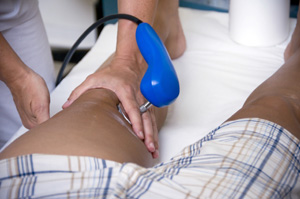Upper Thigh Pain

Facts About Upper Thigh Pain
Everyday hundred upon hundreds of people suffer upper thigh pain. Some, of course can be explained-a known injury, exercise overindulgence or pre-existing condition, while some pain can not be explained without a visit to a physician. This may be due in part by the nerves of our own bodies making home diagnoses almost impossible.
The nerves responsible for bringing information to the brain about the different parts of the body are known as sensory nerves. Messages from the brain to activate muscles, etc., travel through what are known as motor nerves. In order to carry all this out nerves go through a maze passing over, around, under or through tissue, muscle mass, joints, and even bone. As a general rule there is plenty of space for easy passage and accurate messaging. However, these passages-especially in areas around joints where body parts can be easily depressed by movement (thigh/hip area), can be compromised due to swelling, pressure and trauma leaving narrow openings that can squeeze the nerve. This is called nerve compression or entrapment. When this takes place anything from upper thigh pain to paralysis (or any other dysfunctions) can result.
Some of the more common ailments responsible for upper thigh pain are: deep vein thrombosis (may involve blood clots), torn ligaments, pinched nerves, swollen lymph nodes in the groin area, muscle strain, peripheral neuropathy, or an infection of some type. These can involve constant, shooting, irritating or a burning type of pain.
Anterior thigh pain is a misunderstood but common condition caused by lower lumbar or sacroiliac problems, and more than likely an injury due to overuse. It could involve the muscle that runs along the inside of you thigh called the adductor which is the muscle used to turn your toes in or to tense them for balance, etc., and has resulted in a pull to a muscle in the groin area. For some, upper thigh pain can be the result of a foot imbalance-again using the tightened adductor for balance.
Those who are athletic are more prone to injuries such as hamstring pulls or tears causing upper thigh pain along the back-side. This is commonly confused with sciatica so again use caution with home diagnoses. This can be especially true as treatment for a pulled or torn hamstring can greatly aggravate sciatica problems (pain usually targets the outer upper thigh but can travel all the way to the foot).
This is equally true for quadriceps pulls or tears which will cause a sudden sharp upper thigh pain to the front-side, and can include swelling and/or bruising. The iliopsoas is a deep muscle which begins on the front of your lumbar spine. From here it goes through the inside of the pelvic bone before being inserted onto the top, inner side of the thigh bone. Either of these muscles can be repetitively strained as a person runs everyday causing either constant or shooting pain.
X-rays can be of help in trying to identify upper thigh pain. They can spot bone abnormalities that could be resting in such a way as to put pressure on the nerve, issue areas or muscles. Though, there are many ways to treat upper thigh pain, they are largely dependant on the source of pressure/root of problem. A few basic rules of thumb outside removing any undue pressure to the area would be refraining from any type of aggravating activity, loose weight if you need to, wear loose or unrestricting clothing whenever possible and if you are in a profession that demands stressing certain muscles or parts of the back/legs, etc., take every precaution.